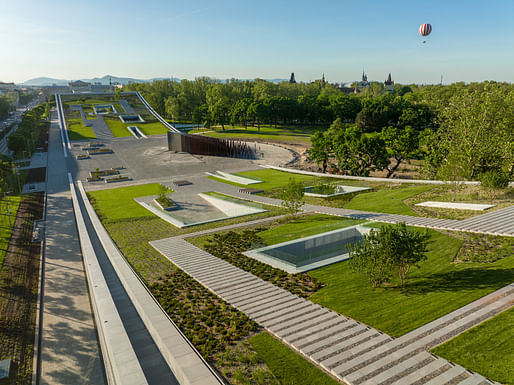
Photos of the recently inaugurated award-winning new Museum of Ethnography in Budapest’s Városliget City Park by NAPUR Architect Ltd have been released.
The museum is a part of the larger Liget Budapest development and marks the first time in the 150-year history of the institution that its 250,000 object collection will be stored in one contiguous facility.
The local studio beat out international heavyweight such as Zaha Hadid to win the commission for the project, which the jury commended as being “distinguished by a dynamic yet simple design harmonized with the natural environment of the park while communicating with the urban texture of its surroundings.”
As NAPUR describes: “The gently curving lines enable the building to function as a gateway and a passage linking the city and the park. Sixty percent of the structure is under ground level, and thanks to the landscaped roof and the transparency of the sections over the ground, the new museum is adapted to its environment in its scale too. The grass-covered roof area will be a pleasant community space awaiting visitors to Városliget.”
“The spectacular trademark of the building is the glass curtain wall surrounding the landscaped roof garden, reminiscent of two intertwined hillsides, with a unique characteristic, consisting of nearly half a million pixels, a raster made by metal grid based on ethnographic motifs selected from the museum's Hungarian and international collections. The pixels were inserted into a laser-cut aluminum grid by a special robot, more than 2,000 of which are attached to the building. The small cubes were made up of 20 Hungarian and 20 international contemporary reinterpretations of ethnographic motifs.”

“The creatively built spaces will open up new opportunities to communicate with visitors, enabling the presentation of the everyday objects, phenomena and ideas of the past and the present side by side. The purpose-built museum was designed with maximum consideration for the required functions, and thus facilitates the large-scale, modern, user-friendly operation of the institution to a significant degree, along with the visually enticing and diverse display of mankind’s material and spiritual heritage, as well as the collection comprising Hungarian and international material.”
According to the architects, all the new features are meant to facilitate a simultaneous understanding of the heritage of the region and various aspects of contemporary society. The museum joins Sou Fujimoto's inspiring House of Music, which opened in January, the forthcoming SANAA-designed New National Gallery, and the renovated NEO Contemporary Art Space, which opened at the end of 2019.
No Comments
Block this user
Are you sure you want to block this user and hide all related comments throughout the site?
Archinect
This is your first comment on Archinect. Your comment will be visible once approved.